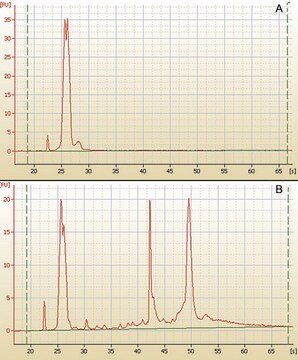HCA-7 Colony 29
2091238, human colon, Epithelial
Zaloguj sięWyświetlanie cen organizacyjnych i kontraktowych
About This Item
Kod UNSPSC:
41106514
pochodzenie biologiczne:
human colon
tryb wzrostu:
Adherent
kariotyp:
Near Diploid
morfologia:
Epithelial
produkty:
Expresses Cox-2
receptory:
EGF. Parent HCA-7 cell line: wildtype APC. Known mutations:Parent HCA-7 cell line: RER phenotype, p53
powiązane choroby:
cancer
Polecane produkty
Nazwa produktu
HCA-7 Colony 29, 02091238
pochodzenie biologiczne
human colon
tryb wzrostu
Adherent
kariotyp
Near Diploid
morfologia
Epithelial
produkty
Expresses Cox-2
receptory
EGF. Parent HCA-7 cell line: wildtype APC. Known mutations:Parent HCA-7 cell line: RER phenotype, p53
metody
cell culture | mammalian: suitable
powiązane choroby
cancer
Warunki transportu
dry ice
temp. przechowywania
−196°C
Pochodzenie linii komórkowej
Human Colon Carcinoma (subpopulation isolated from the HCA-7 cell line)
Opis linii komórkowej
The human colon cancer cell line, HCA-7 Colony 29 expresses Cox-2. An interesting feature of this cell line is that it forms polarised epithelial sheets which allows examination of the trafficking and release of biomolecules in vitro. Cyclooxygenases (COXs) are key enzymes in the conversion of arachidonic acid to prostaglandins and other eicosanoids. It has been found that colonic polyps and cancers overexpress Cox-2 and that the inhibition of this enzyme by nonsteroidal anti-inflammatory drugs decreases the risk of colonic neoplasia. This cell line is useful for studying the role of Cox-2 in cancer cell biology and the investigation of colorectal epithelial cell polarity. Imperial College Innovations has stated that this cell line is not to be supplied to commercial organisations.
Profil DNA
STR-PCR Data: Amelogenin: X
CSF1PO: 11,14
D13S317: 9
D16S539: 10,11
D5S818: 8,12
D7S820: 11,12
THO1: 6,7
TPOX: 8,10
vWA: 14,16
CSF1PO: 11,14
D13S317: 9
D16S539: 10,11
D5S818: 8,12
D7S820: 11,12
THO1: 6,7
TPOX: 8,10
vWA: 14,16
pożywka hodowlana
DMEM + 10% FBS + 2mM L-Glutamine + 110mg/L Sodium Pyruvate (NaP).
Rutyna subkultury
Split sub-confluent cultures (70-80%) 1:5 to 1:10 i.e. seeding at 1-2x10,000 cells/cm2 using 0.05% trypsin/EDTA; 5% CO2; 37°C.
Inne uwagi
Additional freight & handling charges may be applicable for Asia-Pacific shipments. Please check with your local Customer Service representative for more information.
Oświadczenie o zrzeczeniu się odpowiedzialności
This cell line has special release conditions: Commercial organisations are required to complete the ′Cell Line Release Authorisation for Research Use in Commercial Organisations′ release conditions form.
Ta strona może zawierać tekst przetłumaczony maszynowo.
Wybierz jedną z najnowszych wersji:
Certyfikaty analizy (CoA)
Lot/Batch Number
Przepraszamy, ale COA dla tego produktu nie jest aktualnie dostępny online.
Proszę o kontakt, jeśli potrzebna jest pomoc Obsługa Klienta
Masz już ten produkt?
Dokumenty związane z niedawno zakupionymi produktami zostały zamieszczone w Bibliotece dokumentów.
Nasz zespół naukowców ma doświadczenie we wszystkich obszarach badań, w tym w naukach przyrodniczych, materiałoznawstwie, syntezie chemicznej, chromatografii, analityce i wielu innych dziedzinach.
Skontaktuj się z zespołem ds. pomocy technicznej

